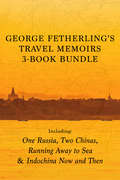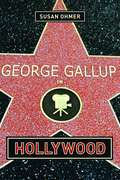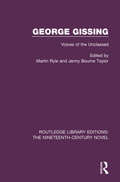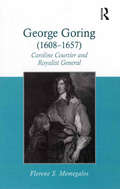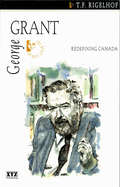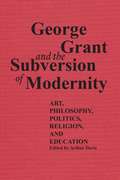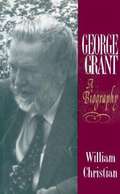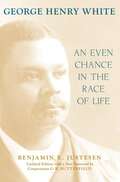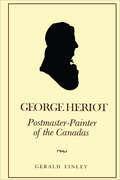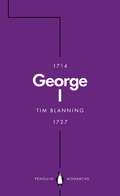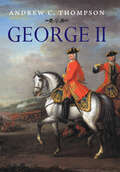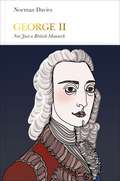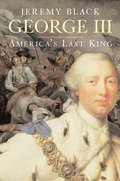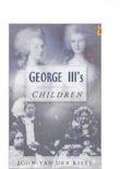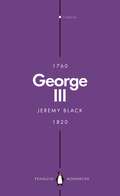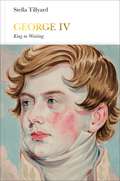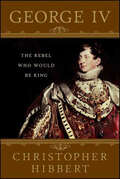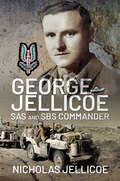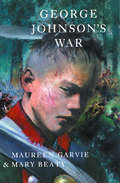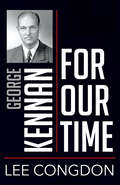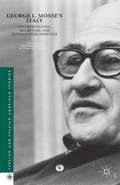- Table View
- List View
George Fetherling's Travel Memoirs 3-Book Bundle: One Russia, Two Chinas / Running Away to Sea / Indochina Now and Then
by George FetherlingThe travel writing of celebrated writer George Fetherling is filled with vivid prose and bizarre characters. Includes: One Russia, Two Chinas A travel narrative written over the course of ten years, One Russia, Two Chinas is about change and resistance to change in the postmodern world. A valuable document that freezes some important world events for close inspection. Running Away to Sea: Round the World on a Tramp Freighter At a turning point in his life, George Fetherling embarked on an adventure to sail round the world on one of the last of the tramp freighters. The four-month voyage carried him 30,000 nautical miles from Europe via the Panama Canal to the South Pacific and back by way of Singapore, Indonesia, the Indian Ocean, and Suez. Written with dash, colour, and droll humour, Fetherling’s narrative is peopled by a rich cast of characters, from the Foreign Legionnaires of French Polynesia to the raskol gangs of Papua New Guinea. Indochina Now and Then George Fetherling recounts multiple journeys through Vietnam, Laos, and Cambodia, keeping an eye peeled and an ear cocked for whatever faint traces of French rule might remain. Indochina Now and Then is a travel narrative that leaves an indelible impression in the readers imagination.
George Gallup in Hollywood
by Susan OhmerA fascinating look at the film industry's use of opinion polling in the 1930s and '40s.
George Gallup in Hollywood (Film and Culture Series)
by Susan OhmerGeorge Gallup in Hollywood is a fascinating look at the film industry's use of opinion polling in the 1930s and '40s. George Gallup's polling techniques first achieved fame when he accurately predicted that Franklin D. Roosevelt would be reelected president in 1936. Gallup had devised an extremely effective sampling method that took households from all income brackets into account, and Hollywood studio executives quickly pounced on the value of Gallup's research. Soon he was gauging reactions to stars and scripts for RKO Pictures, David O. Selznick, and Walt Disney and taking the public's temperature on Orson Welles and Desi Arnaz, couples such as Fred Astaire and Ginger Rogers, and films like Gone with the Wind, Dumbo, and Fantasia. Through interviews and extensive research, Susan Ohmer traces Gallup's groundbreaking intellectual and methodological developments, examining his comprehensive approach to market research from his early education in the advertising industry to his later work in Hollywood. The results of his opinion polls offer a fascinating glimpse at the class and gender differences of the time as well as popular sentiment toward social and political issues.
George Gissing: Voices of the Unclassed (Routledge Library Editions: The Nineteenth-Century Novel #33)
by Martin Ryle Jenny Bourne TaylorFirst published in 2005, this collection of essays brings together British, European and North American literary critics and cultural historians with diverse specialities and interests to demonstrate the range of contemporary perspectives through which George Gissing’s fiction can be viewed. It offers both closely contextualised historical readings and broader cultural and philosophical assessments and engages with a number of themes including: the cultural and social formation of class and gender, social mobility and its unsettling effects on individual and collective identities, the place of writing in emerging mass culture, and the possibility and limits of fiction as critical intervention. This book will be of interest to those studying the works of George Gissing, and 19th century literature more broadly.
George Goring (1608–1657): Caroline Courtier and Royalist General
by Florene S. MemegalosGeorge Goring was in many ways the archetypal cavalier, often portrayed as possessing all the worst characteristics associated with the followers of King Charles I. He drank copiously, dressed and entertained lavishly, gambled excessively, abandoned his wife frequently, and was quick to resort to swordplay when he felt his honour was at stake. Yet, he was also an active Member of Parliament and a respected soldier, who learnt his trade on the Continent during the Dutch Wars, and put his expertise to good use in support of the royalist cause during the English Civil War.
George Grant
by T. F. RigelhofGeorge Grants Lament for a Nation led some to call him a Red Tory and the dominant force behind the Canadian nationalist movement of the 1970s. Today, reading George Grants books helps us to understand the full implications of American-led, technology-driven globalization on everyday life.
George Grant and the Subversion of Modernity: Art, Philosophy, Religion, Politics and Education (The Royal Society of Canada Special Publications)
by Arthur DavisGeorge Grant's mystique as a public philosopher is due in part to the seemingly contradictory political stances he took through the years. His opposition to the Vietnam war and his linking of liberalism with technological progress and imperialism brought him favour among the political left during the 1960s. Then, in the following decade, his opposition to abortion earned him allies on the political right, despite his rejection of limitless capitalist growth and free trade with the US. This collection of original essays reveals the complex philosophic, artistic, and religious sources underlying Grant's public positions of nationalism, pacifism, and conservatism.The collection begins with Grant's previously unpublished writing on Céline. This is a bold and vigorous Grant, writing on a topic about which he is passionate and deeply informed. Grant's own work is followed by two pieces that explore his devotion to Céline, Nietzsche, Heidegger, Weil, and Strauss also receive special attention here. Many of the essays draw on manuscripts and notes left unpublished by Grant, thus contributing new perspectives to the ongoing discussion of his work.The focus of this book is the unknown George Grant, namely, the philosophic, religious, and artistic inspiration behind his well-known public positions. Here we discover the great modern thinkers who animated Grant, and whose writings occupied him for much of his life.
George Grant: A Biography
by William ChristianThis book sheds light on Grant's early intellectual interests, the centrality of his pacifism, his struggle to educate himself as a philosopher (he studied history at Queen's University and law at Oxford), his ambivalent relationship to organized religion, his quarrels with York and McMaster Universities, and his attitude to John Diefenbaker.
George Henry White: An Even Chance in the Race of Life (Southern Biography Series)
by Benjamin R. Justesen G. K. ButterfieldAlthough he was one of the most important African American political leaders during the last decade of the nineteenth century, George Henry White has been one of the least remembered. A North Carolina representative from 1897 to 1901, White was the last man of his race to serve in the Congress during the post-Reconstruction period, and his departure left a void that would go unfilled for nearly thirty years. At once the most acclaimed and reviled symbol of the freed slaves whose cause he heralded, White remains today largely a footnote to history. In this exhaustively researched biography, Benjamin R. Justesen rescues from obscurity the fascinating story of this compelling figure's life and accomplishments.The mixed-race son of a free turpentine farmer, White became a teacher, lawyer, and prosecutor in rural North Carolina. From these modest beginnings he rose in 1896 to become the only black member of the House of Representatives and perhaps the most nationally visible African American politician of his time. White was outspoken in his challenge to racial injustice, but, as Justesen shows, he was no militant racial extremist as antagonistic white democrats charged. His plea was always for simple justice in a nation whose democratic principles he passionately loved. A conservative by philosophy, he was a dedicated Republican to the end. After he retired from Congress, he remained active in the fight against racial discrimination, working with national leaderas of both races, from Booker T. Washington to the founders of the NAACP. Through judicious use of public documents, White's speeches, newspapers, letters, and secondary sources, Justesen creates an authoritative and balanced portrait of this complex man and proves him to be a much more effective leader than previously believed.
George Heriot: Postmaster-Painter of the Canadas
by Gerald FinleyGeorge Heriot (1759-1839), a Scot, is best known as a skilled landscape watercolourist and as the contentious deputy postmaster general of British North America from 1800 to 1816. He was also a travel writer (his Travels through the Canadas was published in 1807) and a poet. In this volume, a combination of biography and art history, Gerald Finley presents, for the first time, a rounded picture of Heriot, revealing his motives and ideals while also illuminating the texture of life in Canada during the early years of settlement. In describing Heriot's several roles as artist, administrator, patriot, spy, Finley presents a portrait of an eighteenth-century gentleman whose superficial desires were for an active public life but whose deeper yearnings were for a life of contemplation. As a member of the gentry it was natural that Heriot found his way into public service, for which he was suited both by education and by upbringing. Nevertheless, his public career did not always run smoothly and it ended in frustration and sadness. However, through his writing and especially his art Heriot found welcome relief from the tensions of his public duties. Indeed, Heriot's chief importance lies in his art. Trained as a topographical artist, he was an important exponent of the picturesque landscape. As a mode of vision the Picturesque furnished him with a special way of looking at recording the Canadian scene – to him Canada possessed the qualities of Arcadia. This viewpoint served both as aesthetic consolation and as stimulus to inspiration. This volume serves to recognize Heriot's artistic achievement and to accord him the place he deserves in the history of Canadian art and of the country itself.
George I. Sánchez
by Carlos Kevin BlantonGeorge I. Sánchez was a reformer, activist, and intellectual, and one of the most influential members of the "Mexican American Generation" (1930-1960). A professor of education at the University of Texas from the beginning of World War II until the early 1970s, Sánchez was an outspoken proponent of integration and assimilation. He spent his life combating racial prejudice while working with such organizations as the ACLU and LULAC in the fight to improve educational and political opportunities for Mexican Americans. Yet his fervor was not always appreciated by those for whom he advocated, and some of his more unpopular stands made him a polarizing figure within the Latino community.Carlos Blanton has published the first biography of this complex man of notable contradictions. The author honors Sánchez's efforts, hitherto mostly unrecognized, in the struggle for equal opportunity, while not shying away from his subject's personal faults and foibles. The result is a long-overdue portrait of a towering figure in mid-twentieth-century America and the all-important cause to which he dedicated his life: Mexican American integration.
George I: The Lucky King (Penguin Monarchs)
by Tim BlanningGeorge I was not the most charismatic of the Hanoverian monarchs to have reigned in England but he was probably the most important. He was certainly the luckiest.Born the youngest son of a landless German duke, he was taken by repeated strokes of good fortune to become, first the ruler of a major state in the Holy Roman Empire of the German Nation and then the sovereign of three kingdoms (England, Ireland and Scotland). Tim Blanning's incisive short biography examines George's life and career as a German prince, and as King. Fifty-four years old when he arrived in London in 1714, he was a battle-hardened veteran, who put his long experience and deep knowledge of international affairs to good use in promoting the interests of both Hanover and Great Britain. When he died, his legacy was order and prosperity at home and power and prestige abroad. Disagreeable he may have been to many, but he was also tough, determined and effective, at a time when other European thrones had started to crumble.
George II: King and Elector (The English Monarchs Series)
by Andrew C. ThompsonDespite a long and eventful reign, Britain's George II is a largely forgotten monarch, his achievements overlooked and his abilities misunderstood. This landmark biography uncovers extensive new evidence in British and German archives, making possible the most complete and accurate assessment of this thirty-three-year reign. Andrew C. Thompson paints a richly detailed portrait of the many-faceted monarch in his public as well as his private life. Born in Hanover in 1683, George Augustus first came to London in 1714 as the new Prince of Wales. He assumed the throne in 1727, held it until his death in 1760, and has the distinction of being Britain's last foreign-born king and the last king to lead an army in battle. With George's story at its heart, the book reconstructs his thoughts and actions through a careful reading of the letters and papers of those around him. Thompson explores the previously underappreciated roles George played in the political processes of Britain, especially in foreign policy, and also charts the intricacies of the king's complicated relationships and reassesses the lasting impact of his frequent return trips to Hanover. George II emerges from these pages as an independent and cosmopolitan figure of undeniable historical fascination.
George II: Not Just a British Monarch (Penguin Monarchs)
by Norman DaviesFrom the celebrated historian and author of Europe: A History, a new life of George IIGeorge II, King of Great Britain and Ireland and Elector of Hanover, came to Britain for the first time when he was thirty-one. He had a terrible relationship with his father, George I, which was later paralleled by his relationship to his own son. He was short-tempered and uncultivated, but in his twenty-three-year reign he presided over a great flourishing in his adoptive country - economic, military and cultural - all described with characteristic wit and elegance by Norman Davies. (George II so admired the Hallelujah chorus in Handel's Messiah that he stood while it was being performed - as modern audiences still do.) Much of his attention remained in Hanover and on continental politics, as a result of which he was the last British monarch to lead his troops into battle, at Dettingen in 1744.
George III
by Jeremy BlackThe sixty-year reign of George III (1760-1820) witnessed and participated in some of the most critical events of modern world history: the ending of the Seven Years' War with France, the American War of Independence, the French Revolutionary Wars, the campaign against Napoleon Bonaparte and battle of Waterloo in 1815, and Union with Ireland in 1801. Despite the pathos of the last years of the mad, blind, and neglected monarch, it is a life full of importance and interest.Jeremy Black's biography deals comprehensively with the politics, the wars, and the domestic issues, and harnesses the richest range of unpublished sources in Britain, Germany, and the United States. But, using George III's own prolific correspondence, it also interrogates the man himself, his strong religious faith, and his powerful sense of moral duty to his family and to his nation. Black considers the king's scientific, cultural, and intellectual interests as no other biographer has done, and explores how he was viewed by his contemporaries. Identifying George as the last British ruler of the Thirteen Colonies, Black reveals his strong personal engagement in the struggle for America and argues that George himself, his intentions and policies, were key to the conflict.
George III's Children
by John KisteOn 12 August 1762, Queen Charlotte gave birth to her first child. Twenty-one years later, to the week, the 15th and youngest was born. All but two children survived to maturity. The eldest of King George III's children, who became Prince Regent and King George IV, is less remembered for his patronage of the arts than for his extravagance, and maltreatment of his wife Caroline. As Commander-in-Chief to the British army, the administrative qualities of Frederick, Duke of York are largely forgotten, while King William IV, usually dismissed as a figure of fun, brought a new affability to the monarchy which helped him through the storms engendered during the passage of the Great Reform Bill in 1832. The princesses, for many years victims of their parents' possessiveness, married late in life, if at all, and are passed off as non-entities. This objective portrayal of the royal family draws upon contemporary sources to lay to rest the gossip and exaggeration.
George III's Illnesses and his Doctors: A Study in Early Psychiatry
by Michael RamscarIn the late eighteenth century mental illness was treated with brutal and inhumane methods by ‘mad-doctors’, and the treatment of George III was no exception. George III’s Illnesses and His Doctors provides an insightful, forensic and sympathetic picture of how and why members of the royal family turned in desperation to an unqualified quack practitioner, James Lucett, in the hope of finding a cure for the king’s ‘insanity’. Much has been written in the past about ‘Mad King George’. This book brings fresh evidence and new understanding to the case of the ‘mad’ king. Lucett’s claims were tested in psychiatry’s first ‘therapeutic trial’ and science was invoked in an attempt to improve understanding of the roots of insanity. The results were mixed but nevertheless George III’s case and the subsequent career of the deeply flawed Lucett were important elements in the revolutionary change in attitudes to the treatment of the insane which came about as the nineteenth century progressed. Based closely on primary source material, George III’s Illnesses and His Doctors is a moving story of human suffering but also of efforts to challenge medical orthodoxy and to improve understanding of mental illness. Some of the issues raised in the early nineteenth century remain to be resolved now.
George III: Madness and Majesty (Penguin Monarchs)
by Jeremy BlackKing of Britain for sixty years and the last king of what would become the United States, George III inspired both hatred and loyalty and is now best known for two reasons: as a villainous tyrant for America's Founding Fathers, and for his madness, both of which have been portrayed on stage and screen.In this concise and penetrating biography, Jeremy Black turns away from the image-making and back to the archives, and instead locates George's life within his age: as a king who faced the loss of key colonies, rebellion in Ireland, insurrection in London, constitutional crisis in Britain and an existential threat from Revolutionary France as part of modern Britain's longest period of war.Black shows how George III rose to these challenges with fortitude and helped settle parliamentary monarchy as an effective governmental system, eventually becoming the most popular monarch for well over a century. He also shows us a talented and curious individual, committed to music, art, architecture and science, who took the duties of monarchy seriously, from reviewing death penalties to trying to control his often wayward children even as his own mental health failed, and became Britain's longest reigning king.
George IV: King in Waiting (Penguin Monarchs)
by Stella TillyardGeorge IV spent most of his life waiting to become king: as a pleasure-loving and rebellious Prince of Wales during the sixty-year reign of his father, George III, and for ten years as Prince Regent, when his father went mad. 'The days are very long when you have nothing to do' he once wrote plaintively, but he did his best to fill them with pleasure - women, art, food, wine, fashion, architecture. He presided over the creation of the Regency style, which came to epitomise the era, and he was, with Charles I, the most artistically literate of all our kings. Yet despite his life of luxury and indulgence, George died alone and unmourned. Stella Tillyard has not written a judgemental book, but a very human and enjoyable one, about this most colourful of all British kings.
George IV: The Rebel Who Would Be King
by Christopher Hibbert“One of the most satisfying biographies of an English king: it is ample, convincing and well written”—from the acclaimed author of The House of Medici (The Times Literary Supplement).Christopher Hibbert delivers a superbly detailed picture of the life and times of George IV including his exorbitant spending on his homes, his clothes, and his women; his patronage of the arts; his “illegal” marriage to Catholic Mrs. Fitzherbert, and lesser known facts such as his generous charity donations and his witty one-liners, including one he uttered when he met his bride-to-be (Caroline of Brunswick) for the first time: “Harris, I am not well, fetch me a brandy.” George IV was the son of George III (who went insane and inspired The Madness of King George) and was the founder of the prestigious King’s College in London.“A delight to read . . . an enormously enjoyable and skillful portrait.” —Philip Ziegler, The Spectator“Christopher Hibbert’s George IV is at once soundly based on research in the Royal Archives at Windsor and a rollicking good read. I found it invaluable when I was researching The Unruly Queen, my life of George IV’s wife, Queen Caroline, and I recommend it to anyone interested by George IV’s flamboyant and outrageous personality.” —Flora Fraser, author of Flora Macdonald: “Pretty Young Rebel”
George Jellicoe: SAS and SBS Commander
by Nicholas C. JellicoeGeorge Jellicoe, son of Admiral Sir John Jellicoe, commander of the British Grand Fleet at Jutland, was never compromised by his privileged upbringing. In this insightful biography, his son describes a life of action, drama, public service and controversy. George’s exploits with the newly formed SAS, as David Stirling’s second-in-command, and later commanding the SBS, make for fascinating reading. Over four years it embraced the North African and Mediterranean campaigns and culminated in the saving of a newly-liberated Athens from the communist guerrillas of ELAS. The brutality of Stalinist communism led him to join the post-war Foreign Office. In Washington he worked with Kim Philby and Donald Maclean in the cloak and dagger world of espionage. Resigning in 1958 so he could marry the woman he loved, he turned to politics. Although his ministerial career ended in 1973 after unwittingly become entangled with the Lambton scandal, he continued to sit in the House of Lords becoming ‘Father of the House’. He held numerous public appointments including President of the Royal Geographical Society, Chairman of the Medical Research Council, President of the SAS Regimental Association and the UK Crete Veterans Association. Thanks to the author’s research and access, this is more than a biography of a significant public figure. It provides fascinating detail of Special Forces operations and the characters of the countless figures with whom he mixed.
George Johnson's War
by Maureen Garvie Mary BeatyGeorge's cloistered life in New York changes as the War for American Independence looms and he must struggle with what it means to be half Mohawk. Young George Johnson lives in an extraordinary family in extraordinary times. His father is Sir William Johnson, one of the richest and most powerful men in colonial New York. His mother is Molly Brant, stepdaughter of a Mohawk chief and sister of Iroquois leader Joseph Brant. George spends his early years in a grand mansion called Johnson Hall, but his cloistered life changes as the War for American Independence looms. As the rebel forces gradually take over the valley, George and his family are forced to flee their home and seek refuge with Molly's friends and relatives. George longs to follow his brother's footsteps into battle. Instead, Molly sends him to boarding school in Montreal, where he spends three miserable years waiting for Peter's return. Finally, at the age of thirteen, he persuades his mother to allow him to join in a last raid on the valley where he grew up. In a riveting climax, he experiences first-hand the inglorious brutality and futility of the war, and struggles with what it means to be half Mohawk. And at last he learns the hard truth about the fate of his beloved brother. Correlates to the Common Core State Standards in English Language Arts: CCSS.ELA-LITERACY.RL.6.3 Describe how a particular story's or drama's plot unfolds in a series of episodes as well as how the characters respond or change as the plot moves toward a resolution. CCSS.ELA-LITERACY.RL.6.6 Explain how an author develops the point of view of the narrator or speaker in a text.
George Kennan for Our Time (People for Our Time)
by Lee CongdonGeorge Kennan for Our Time examines the work and thought of the most distinguished American diplomat of the twentieth century and extracts lessons for today. In his writings and lectures, Kennan outlined the proper conduct of foreign policy and issued warnings to an American society on the edge of the abyss. Lee Congdon identifies the principles Kennan applied to US relations with Russia and Eastern Europe, and to the Far and Near East. He takes particular note of Kennan's role in formulating postwar policy in Japan, measured response to North Korea's invasion of South Korea, and opposition to the war in Vietnam. Congdon also considers Kennan's strong criticisms of his own country, its egalitarianism, unrestricted immigration, and multiple addictions. He cites Kennan's call for a greater closeness to nature, a revival of religious faith, and a return to the representative government established by the Founding Fathers. George Kennan for Our Time describes the often-disastrous results of rejecting Kennan's counsel, and the dangers, international and national, posed by an ongoing failure to draw upon his wisdom. In view of America's foreign policy disasters in Afghanistan, Iraq, and around the world, Kennan's realist approach provides important lessons for our current age.
George L. Mosse’s Italy
by Lorenzo Benadusi Giorgio CaravaleTwelve years have gone by since the passing of George L. Mosse, yet his work still provides essential tools for historical analysis and influences contemporary research. This volume provides a re-examination of his historiographical production and an analysis of his influence in the context of Italian history.
